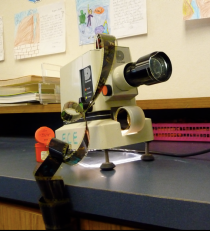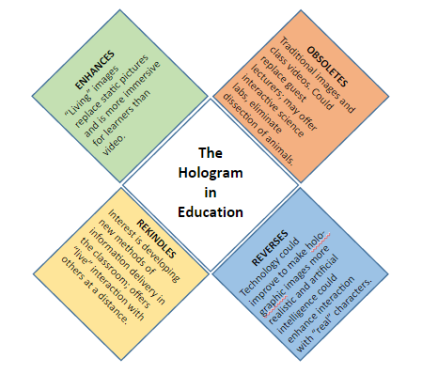The projection of holograms is an emerging and rapidly-developing technology with fairly old roots, and great potential for the future. As early as the 1860s, theaters created what appeared to be 3-D, floating images by projecting pictures onto glass at an angle to the audience (Lee, 2013). More recently, holograms have been produced by projecting from various angles onto special aluminum “foil” sheets. Musion, a leading hologram developer, has produced lectures starring HRH Charles, Prince of Wales, addressing an energy summit. The technology is becoming so realistic that Musion’s “Tupak Shakur” image appeared to be a reincarnation of the late rapper (Musion, 2014).
The Enhancement: Holograms can enhance the classroom experience at many levels. Students might be able to have a holographic Thomas Jefferson come to tell them about the Revolutionary war, or they might observe a “live” dissection in biology class, enhanced by the 3D imagery. Holographic technology also makes it possible to “appear” to many classrooms simultaneously from a distance.
The Obsolescence: With the recent improvements, holograms offer educators an opportunity t o engage students with “living” media which can replace (or make obsolete) the outdated still images in slide shows, as well as the sometimes stale videos that are part of ordinary classroom experiences. For folks of a “certain age” who remember the ubiquitous filmstrip of the 50s and 60s, the holographic project seems to be a magic we could only imagine, and it doesn’t require a “ding” to remind teachers to switch to the next frame.
o engage students with “living” media which can replace (or make obsolete) the outdated still images in slide shows, as well as the sometimes stale videos that are part of ordinary classroom experiences. For folks of a “certain age” who remember the ubiquitous filmstrip of the 50s and 60s, the holographic project seems to be a magic we could only imagine, and it doesn’t require a “ding” to remind teachers to switch to the next frame.
The Rekindling: Holograms in the classroom rekindle the mission to make education more relevant, exciting, and engaging (Bhashkar, 2013). The ability to interact with others using holography to speak to multiple classes at once opens new outlets for collaboration that rarely occur in many classes. Students who are already collaborating online with learners in other schools will find the 3D, more realistic imagery brings their cohorts “closer” in real time. Ghuloum’s (2010) research demonstrated that while many teachers expect holograms to be far off because of the costs associated with the technology, they are enthusiastic to see it develop and join the mainstream of educational technology.

The Reversal: We can imagine the next technology to follow holograms might be more interactive through the use of Artificial Intelligence (AI). As the science of holography continues to reveal new uses and better, cheaper equipment needs, one can envision a “holodeck” where students can interact with historical characters, tour ancient cities, or play learning games with their holographic cohorts from many places.
We have become familiar with the idea of holograms because of movies and television where the technology appears mainstream, from the image of a damsel in distress in the first Star Wars movie to the weekly forays onto the holodeck in the various iterations of Star Trek. Although we may still think of holograms as a science fiction “someday” technology, they are here, and they are improving rapidly in response to the demands of the tech industry as a whole. The medium may become the message, with the message being “see me in 3D, and interact with me for deeper learning.”
References
Bhashkar, S (2013). Potential and Applications of Holograms To Engage Learners. Retrieved from EdTech Review: http://edtechreview.in/trends-insights/trends/521-applications-of-holograms-to-engage-learners.
Ghuloum, H. (2010). 3D Hologram Technology in Learning Environment. Proceedings of Informing Science & IT Education Conference (InSITE) 2010. Retrieved from http://proceedings.informingscience.org/InSITE2010/InSITE10p693-704Ghuloum751.pdf
Lee, H. (2013). 3D Holographic Technology and Its Educational Potential. Techtrends: Linking Research & Practice To Improve Learning, 57(4), 34-39. doi:10.1007/s11528-013-0675-8
Musion. (2014). Education. Retrieved from http://musion.com/projects/?pagename=projects&tag=education
Walsh, K., and Taylor, P. (2012).7 Ways holographic technology will make learning more fun. Emerging EdTech. http://www.emergingedtech.com/2012/11/7-ways-holographic-technology-will-make-learning-more-fun/
Photo Credits
Filmstrip projector: https://emergingtech8342.files.wordpress.com/2014/09/accf6-picture24.png
Prince Charles: http://www.dailymail.co.uk/news/article-502599/Prince-Charles-appear-conference-hologram.html

Hi Lyn, I really like the way you explained your tetrad on the use of holograms not only in education but its effectiveness globally. We have seen the 3-D holograms of rock star concerts. I think students in education will become more immersed in curricula if they can interact with the characters of whom they are studying. Star Wars and Star Trek are coming to life as we progress technologically through history.
LikeLike
Hi Lyn –
I did enjoy reading your blog on holograms. I also agree with the prediction of one day students having a “holodeck” where they can interact with historical figures.
Thanks,
Vaughn
LikeLike
Hello Lyn,
I agree with your overall summary of holograms; however, the “holodeck idea” sounds more like just some prototyping model or room. Ultimately, I see everyone having their own “holodeck” devices just like any smartphones or tablet devices. One just has to look at the Gorillaz & Madonna: Grammy Awards so to see the open possibilities.
http://www.eyeliner3d.com/gorillaz_madonna_grammy_awards.html
LikeLike